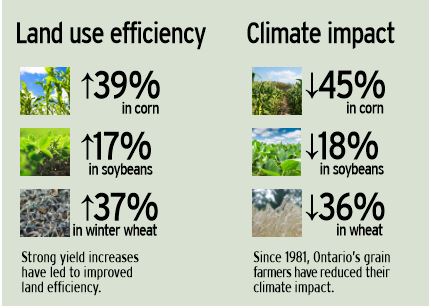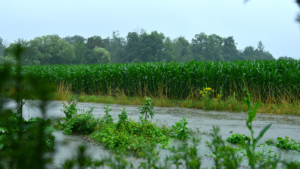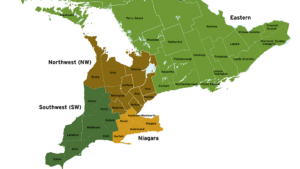Reducing fertilizer emissions
STRIVING FOR ENVIRONMENTAL SUSTAINABILITY

| WHAT YOU NEED TO KNOW • The Government of Canada has proposed a voluntary 30 per cent reduction target of fertilizer emissions. • The proposed target does not mean a 30 per cent reduction in fertilizer use but rather an absolute or total emission reduction of N20 emissions from fertilizer applications. • Nitrogen can be lost into the environment through denitrification, volatilization, leaching, run-off, and erosion. • Utilizing the 4R nutrient management framework can help farmers achieve a reduction in N20 emissions. |
IN DECEMBER 2020, the Government of Canada proposed a fertilizer emissions reduction target. The proposed target is looking at a voluntary commitment to reduce nitrous oxide (N2O) emissions from fertilizer applications by 30 per cent below 2020 levels by the year 2030.
CLIMATE TARGETS
The Government of Canada has committed to greenhouse gas (GHG) emissions reduction targets by signing the Paris Agreement. Within this, Canada has set targets and is evaluating every sector’s GHG emissions and opportunities to reduce them. The most recent targets are looking at ways for Canada to reduce GHG emissions by 40 to 45 percent by 2030 according to 2005 levels.
The Environment and Climate Change Canada (ECCC) climate report titled, A Healthy Environment and Healthy Economy, proposed a voluntary target to reduce N2O emissions from fertilizer applications by 30 per cent below 2020 levels by 2030.
The proposed target does not mean a 30 per cent reduction in fertilizer use but rather an absolute or total emissions reduction in N2O emissions from fertilizer application by 30 per cent. This is a key part of the target that has gained a lot of attention, but what does this mean?
Absolute or total emissions looks at the total quantity of greenhouse gas emissions. In the case of the fertilizer emissions target, the Government of Canada is looking at reducing the total quantity of fertilizer N2O emissions in 2020 by 30 per cent by the year 2030. Regardless of what happens in the future with crop yields, we need to reduce 30 per cent from the 2020 baseline.
NITROUS OXIDE EMISSIONS (N2O)
To fully understand the scope of the target, we need to understand what it includes — it does not include all crop nutrients and fertilizers. The focus of the proposed target is looking at N2O emissions that can be associated with nitrogen fertilizer applications. We know that nitrogen is a critical nutrient required by plants and is essential to growing a high-yielding and high-quality crop. In some cases, not all nitrogen applied is taken up by plants and can be lost into the environment in different ways as N2O emissions.
N2O emissions have a significant impact on the warming of the atmosphere. It can be equated that N2O has about 300 times the warming potential of carbon dioxide. N2O is released naturally by oceans, soil bacteria, and even manure. Additional sources of N2O include industrial processes, wastewater treatment, combustion of fossil fuels and biomass, soil cultivation practices, and, as mentioned, the use of fertilizers.
Canada’s National Inventory Report (NIR), as reported by the Government of Canada, tracks and reports Canada’s GHG emissions across sectors. Canada’s latest NIR identified that agriculture accounted for 75 per cent of national N2O emissions. Furthermore, nitrogen fertilizer application accounted for 21 per cent of total agricultural emissions.
HOW IS NITROGEN LOST ON THE FARM?
Nitrogen fertilizer is a critical component of crop production to maintain crop yields and quality. Farmers work hard to place fertilizer as efficiently as possible, but there are some instances where not all nitrogen is taken up by the crop and is lost into the environment. Agricultural soils naturally emit N2O, and direct N2O emissions occur from nitrogen fertilizer applications, including manure and fertilizer. N2O emissions are also available following the decomposition of crop residue. The main ways that nitrogen can be lost into the environment are through denitrification, volatilization, leaching, run-off, and erosion. Nitrogen loss can depend on factors like soil type, weather, and climatic conditions that can influence the rate of loss when the right conditions are present.
HOW ARE WE IMPROVING?

Grain Farmers of Ontario have remained committed to reducing our impacts and ensuring our farmer-members have the means to improve economic viability while also reducing environmental loss.
Between 1981 and 2011, our land-use efficiency has increased by 39 per cent in corn, 17 per cent in soybeans, and 37 per cent in winter wheat, meaning Ontario’s grain farmers are producing more with less land. Since 1981, Ontario’s grain farmers have reduced their climate impact by 45 per cent in corn, 18 per cent in soybeans, and 36 per cent in winter wheat.
Grain Farmers of Ontario continues to make significant investments in research that helps to create win-win solutions for our farmer-members. Some of the key research projects we fund include examining nutrient use efficiency within corn, soybean, and wheat rotations along with cover crops and 4R Strategies to mitigate GHG emissions. Research areas focus on economic and environmental sustainability efforts to maximize productivity while reducing environmental impact.
4R Ontario is a nutrient management framework for the Ontario agricultural sector. It was built as a voluntary industry solution that avoids the need for regulation. Ontario is unique with its climate, soils, crops, and agricultural production system, which requires an adaptive management approach. The 4R Nutrient Stewardship is the framework needed to ensure there is no one-size-fits-all approach for improving nutrient use efficiency in Ontario with farmers.
With practices and research in soil health, cover crops, and the 4R Nutrient Stewardship, we are positioning ourselves to better understand our impacts and show measurable economic and environmental improvements.
EMISSIONS INTENSITY REDUCTIONS
Grain Farmers of Ontario want to ensure our farmer-members can continue to use fertilizer in a sustainable way to ensure food security and reduce environmental loss while also maintaining productivity for farmers’ livelihood. Grain Farmers of Ontario is advocating against an absolute emissions reduction target and would like to see an emphasis on emissions intensity reduction. By focusing on nutrient use efficiency and reducing the emissions that it takes to produce a bushel of crop, we can maintain strong yields while working to reduce nutrient loss.
Michael Buttenham is the environment and sustainability lead at Grain Farmers of Ontario. •

























